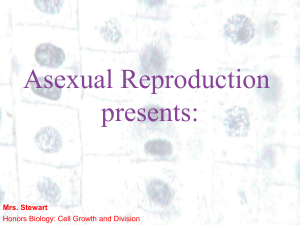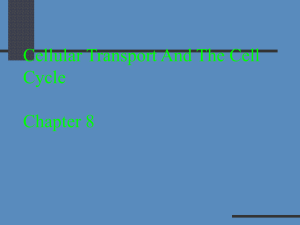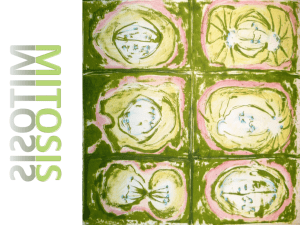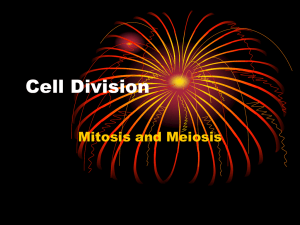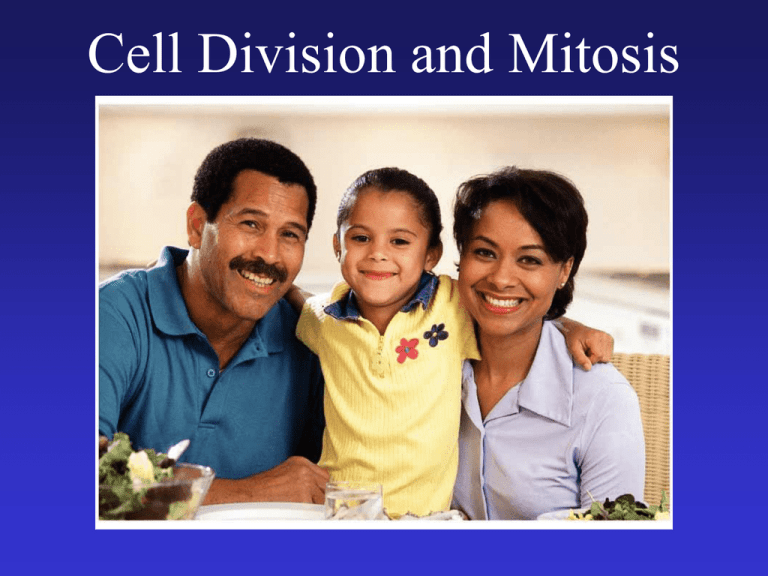
Cell Division and Mitosis
http://www.bioteach.ubc.ca/Teachin
gResources/MolecularBiology/DN
AReplication.swf
http://www.dnai.org/text/mediasho
wcase/index2.html?id=584
http://www.sci.sdsu.edu/multimedia/mitosis/
http://www.johnkyrk.com/mitosis.html
How do little elephants grow up to
be BIG elephants?
By making more cells.
DNA
Why is DNA important?
Because DNA stores
genetic information and is
replicated to pass
information from cell-tocell and generation-togeneration.
Cell
Division
1. Replication
2. Mitosis
3. Cytokinesis
Why do cells
need to divide?
Why do cells need to divide?
1.To make new cells (if you are
injured or growing)
2.Pass on your genes to next
generation (sex)
Cell Cycle
Which phases are part of mitosis?
1. Interphase
2. Prophase
3. Metaphase
4. Anaphase
5. Telophase
6. Cytokinesis
Which
cycle is the
longest?
Interphase
Cell Cycle
Interphase
occurs before mitosis begins
• Chromosomes are __________
copied (# doubles)
• Chromosomes appear as threadlike coils
(chromatin) at the start, but each chromosome and
its copy(sister chromosome) change to sister
chromatids at end of this phase
Nucleus
CELL
MEMBRANE
Cytoplasm
Interphase
Animal Cell
Plant Cell
What happens to the
chromosomes during Interphase?
The chromosomes double
INTERPHASE
DNA is replicated.
•During DNA replication
the DNA separates into
two strands and produces
two new complementary
strands.
•Remember A binds to
T and C binds to ___.
G
___
INTERPHASE
duplicated
chromosome
chromatin
DNA is packed into
______________
Chromosomes after replication.
Chromosomes that are duplicated during
Interphase are called?
INTERPHASE
DNA condensed into visible Chromosomes
95% of the time DNA looks like this in the
_________.
Nucleus
Prophase
1st step in Mitosis
• Mitosis begins (cell begins to divide)
• ____________
Centrioles (or poles) appear and begin to move
to opposite end of the cell.
• Spindle fibers form between the poles.
Sister chromatids
Centrioles
Spindle fibers
Prophase
Spindle fibers
Centrioles
Plant Cell
Animal Cell
Is the right picture or
left picture of a Plant cell?
Metaphase
2nd step in Mitosis
• Chromatids
_____________(or pairs of chromosomes) attach to
the spindle fibers.
Spindle fibers
Centrioles
METAPHASE
____________
Animal Cell
Plant Cell
Anaphase
3rd step in Mitosis
Chromatids
• ______________(or
pairs of chromosomes) separate
and begin to move to opposite ends of the cell.
Spindle fibers
Centrioles
ANAPHASE
____________
Animal Cell
Photographs from: http://www.bioweb.uncc.edu/biol1110/Stages.htm
Plant Cell
Telophase
4th step in Mitosis
nuclei
• Two new _________form.
• Chromosomes appear as chromatin (threads rather
than rods).
• Mitosis ends.
Nuclei
Chromat
in
Nuclei
TELOPHASE
___________
Animal Cell
Photographs from: http://www.bioweb.uncc.edu/biol1110/Stages.htm
Plant Cell
CYTOKINESIS
_____________
occurs after mitosis
• Cell membrane moves inward to create two
daughter cells – each with its own nucleus with
identical chromosomes.
Cytokinesis
Is this an
animal or plant
cell?
In Animal Cells, a
Cleavage Furrow
Forms and
Separates Daughter
Cells
Cleave furrow in a dividing frog cell.
Which process is pictured below?
-Cell Division
-Mitosis or
-Cytokinesis
Cytokinesis
Is this an animal or plant cell?
Which phase has chromatids lined up in the
middle? Interphase
Prophase
Metaphase
Anaphase
Telophase
Cytokinesis
Cell Cycle
Which phase is first in the cell cycle?
The Cell Cycle
INTERPHASE INTERMISSION
PROPHASE PREPARE
METAPHASE
- MIDDLE
CYTOKINESIS CELLS
ANAPHASE APART
TELOPHASE –
TWO NUCLEI
30
30
Cell Cycle
metaphase
interphase
prophase
Why does the cell cycle precisely divide
the duplicated chromosomes into two?
To make each new cell identical with
a complete set of genetic instructions.
Mitosis Precisely and Evenly Divides Duplicated Chromosomes
Is cytokinesis part of mitosis?
No, neither is Interphase.
Mitosis in Action
What
is the
Blue
stuff?
DNA
Cancer Progression
•
•
•
There are many different forms of cancer, affecting
different cell types and working in different ways. All start
out with mutations in specific genes called “oncogenes”.
The normal, unmutated versions of the oncogenes provide
the control mechanisms for the cell. The mutations are
caused by radiation, certain chemicals (carcinogens), and
various random events during DNA replication.
Once a single cell starts growing uncontrollably, it forms a
tumor, a small mass of cells. No further progress can occur
unless the cancerous mass gets its own blood supply.
“Angiogenesis” is the process of developing a system of
small arteries and veins to supply the tumor. Most tumors
don’t reach this stage.
A tumor with a blood supply will grow into a large mass.
Eventually some of the cancer cells will break loose and
move through the blood supply to other parts of the body,
where they start to multiply. This process is called
metastasis. It occurs because the tumor cells lose the
proteins on their surface that hold them to other cells.




